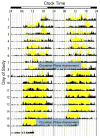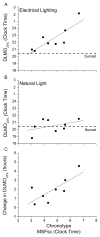Entrainment of the human circadian clock to the natural light-dark cycle
- PMID: 23910656
- PMCID: PMC4020279
- DOI: 10.1016/j.cub.2013.06.039
Entrainment of the human circadian clock to the natural light-dark cycle
Abstract
The electric light is one of the most important human inventions. Sleep and other daily rhythms in physiology and behavior, however, evolved in the natural light-dark cycle [1], and electrical lighting is thought to have disrupted these rhythms. Yet how much the age of electrical lighting has altered the human circadian clock is unknown. Here we show that electrical lighting and the constructed environment is associated with reduced exposure to sunlight during the day, increased light exposure after sunset, and a delayed timing of the circadian clock as compared to a summer natural 14 hr 40 min:9 hr 20 min light-dark cycle camping. Furthermore, we find that after exposure to only natural light, the internal circadian clock synchronizes to solar time such that the beginning of the internal biological night occurs at sunset and the end of the internal biological night occurs before wake time just after sunrise. In addition, we find that later chronotypes show larger circadian advances when exposed to only natural light, making the timing of their internal clocks in relation to the light-dark cycle more similar to earlier chronotypes. These findings have important implications for understanding how modern light exposure patterns contribute to late sleep schedules and may disrupt sleep and circadian clocks.
Copyright © 2013 Elsevier Ltd. All rights reserved.
Figures




Comment in
-
Circadian biology: sleep-styles shaped by light-styles.Curr Biol. 2013 Aug 19;23(16):R689-90. doi: 10.1016/j.cub.2013.06.065. Curr Biol. 2013. PMID: 23968925
References
-
- Pittendrigh CS. Temporal organization: Reflections of a Darwinian clock-watcher. Annu Rev Physiol. 1993;55:17–54. - PubMed
-
- Wurtman RJ. The effects of light on the human body. Sci Am. 1975;233:69–77. - PubMed
-
- Badia P, Myers B, Boecker M, Culpepper J, Harsh JR. Bright light effects on body temperature, alertness, EEG and behavior. Physiol Behav. 1991;50:583–588. - PubMed
-
- Vandewalle G, Maquet P, Dijk DJ. Light as a modulator of cognitive brain function. Trends Cogn Sci. 2009;13:429–438. - PubMed
-
- Rosenthal NE, Sack DA, Carpenter CJ, Parry BL, Mendelson WB, Wehr TA. Antidepressant effects of light in seasonal affective disorder. Am J Psychiatry. 1985;142:163–170. - PubMed
Publication types
MeSH terms
Grants and funding
LinkOut - more resources
Full Text Sources
Other Literature Sources
Medical

